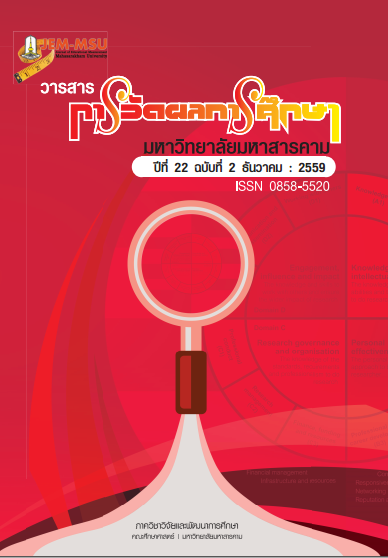The Development of the Learning Activity Arrangement Model and the Evaluation of the Desirable Characteristics of Students at the Institute of Physical Education Based upon the Learning Outcome Standard of the Educational Qualification Framework of the National Higher Education
Main Article Content
Abstract
The research aims 1) to develop the learning activity arrangement model and the
learning evaluation that develop the desirable characteristics of students at the Institute of
Physical Education based upon the learning outcome standard of the educational
qualification framework of the National Higher Education and 2) to test the learning activity
arrangement model and the learning evaluation that develop the desirable characteristics of
students at the Institute of Physical Education based upon the learning outcome standard of
the educational qualification framework of the National Higher Education, a major in physical
education at the Institute of Physical Education Udon Thani who studied the Foundation of
Teaching Profession Course in the Final Semester of Academic Year 2013., which derived
from Simple Random Sampling. Act two groups, the experimental group has used the
number of 30 sophomores with control, the group has used the number of 30 sophomores,
total the number 60 sophomores instrument composes of model. These data were then
reported in descriptive Statistics which were Means, Standard Deviation, Dependent Sample
t-test and Independent Samples t-test for Hypothesis test.
The Results of the study were follows:
1. Receiving the research on the Development of the Learning Activity Arrangement
Model and the Evaluation of the Desirable Characteristics of Students at the Institute of
Physical Education Based upon the Learning Outcome Standard of the Educational
Qualification Framework of the National Higher Education. Referred to as the 5A PLIKA
Model. learning process and Assessment called "5A" composed of 1) Arrangement 2)
Approaching 3) Activity 4) Apply 5) Audit, which learning and assessment called "PLIKA
Model" composed of P : Participation, L: Linked Knowledge, I: Interaction, K : Knowledge
sharing and A : Authentic Assessment. Inclusive
2. The test results of the learning activity arrangement model and the learning
evaluation that develop the desirable characteristics of students of the faculty of education
at the Institute of Physical Education based upon the learning outcome standard of the
educational qualification framework of the National Higher Education have shown that… 1)
the pre-learning average score of the experimental group and that of the control group do
not differ. 2) the post-learning average score of the experimental group is higher than that of
the control group with the statistical significance of .05 3) the post-learning average score of
the Desirable Characteristics of Students at the Institute of Physical Education Based upon
the Learning Outcome Standard of the Educational Qualification Framework of the National
Higher Education of the experimental group is higher than that of the control group all most
with the statistical significance of .05 4) the post-learning average score of the experimental
group is higher than that of the pre-learning score with the statistical significance of .05 5)
the post-learning average score of the experimental group after a two-week learning is higher
than the post-learning average score (immediate) with statistical significance of .05 6) The
students’ stratified toward the learning activity arrangement model and the student
evaluation received from the questionnaires are at high level.
Article Details
The content and information contained in the published article in the Journal of Educational Measurement Mahasarakham University represent the opinions and responsibilities of the authors directly. The editorial board of the journal is not necessarily in agreement with or responsible for any of the content.
The articles, data, content, images, etc. that have been published in the Journal of Educational Measurement Mahasarakham University are copyrighted by the journal. If any individual or organization wishes to reproduce or perform any actions involving the entirety or any part of the content, they must obtain written permission from the Journal of Educational Measurement Mahasarakham University.


